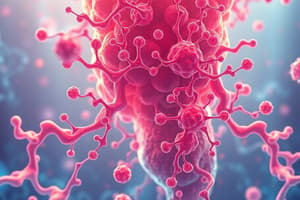Podcast
Questions and Answers
What are the four main steps involved in pharmacokinetics?
What are the four main steps involved in pharmacokinetics?
- Absorption, Distribution, Metabolism, Elimination
- Absorption, Distribution, Elimination, Excretion
- Absorption, Digestion, Metabolism, Excretion
- Absorption, Distribution, Metabolism, Excretion (correct)
What is the main difference between pharmacodynamics and pharmacokinetics?
What is the main difference between pharmacodynamics and pharmacokinetics?
- Pharmacodynamics focuses on the molecular targets of drugs, while pharmacokinetics focuses on the chemical properties of drugs.
- Pharmacodynamics describes how drugs act on the body, while pharmacokinetics describes what the body does to a drug. (correct)
- Pharmacodynamics focuses on the therapeutic effects of drugs, while pharmacokinetics focuses on the side effects of drugs.
- Pharmacodynamics describes what the body does to a drug, while pharmacokinetics describes how drugs act on the body.
What are the two main goals of molecular pharmacology?
What are the two main goals of molecular pharmacology?
- To develop personalized therapies and to predict drug resistance.
- To improve drug bioavailability and to reduce drug-drug interactions.
- To evaluate drug efficacy and to minimize drug side effects.
- To understand how drugs produce their effects and to discover new drug targets. (correct)
Which of these is NOT a valid target for future drug development?
Which of these is NOT a valid target for future drug development?
What is the main challenge in developing drugs that target protein-protein interactions?
What is the main challenge in developing drugs that target protein-protein interactions?
The concept of 'target validation' refers to the process of identifying new therapeutic targets.
The concept of 'target validation' refers to the process of identifying new therapeutic targets.
What is the main difference between a 'me-too' compound and a 'true innovation' in drug development?
What is the main difference between a 'me-too' compound and a 'true innovation' in drug development?
Which of these is an example of a personalized treatment for a genetic disease?
Which of these is an example of a personalized treatment for a genetic disease?
Which of the following is NOT a characteristic of biopharmaceuticals?
Which of the following is NOT a characteristic of biopharmaceuticals?
What is the main factor that explains the increasing popularity of target-oriented pharmacology?
What is the main factor that explains the increasing popularity of target-oriented pharmacology?
What is the primary function of transporters?
What is the primary function of transporters?
Which of these is NOT a characteristic of ABC (ATP binding cassette) family of transporters?
Which of these is NOT a characteristic of ABC (ATP binding cassette) family of transporters?
Which of these transporters is NOT a substrate for P-glycoprotein (P-gp)?
Which of these transporters is NOT a substrate for P-glycoprotein (P-gp)?
What is the primary mechanism by which drugs target transporters?
What is the primary mechanism by which drugs target transporters?
Which of these is NOT a known target for drug-mediated modulation of neurotransmitter transporters?
Which of these is NOT a known target for drug-mediated modulation of neurotransmitter transporters?
Which of the following neurotransmitters is NOT primarily transported by an Na+/Cl- dependent transporter?
Which of the following neurotransmitters is NOT primarily transported by an Na+/Cl- dependent transporter?
Which of these is NOT a known side effect of SSRIs?
Which of these is NOT a known side effect of SSRIs?
Which of the following is a key mechanism by which antidepressants exert their therapeutic effects?
Which of the following is a key mechanism by which antidepressants exert their therapeutic effects?
The concept of 'desensitization' refers to the phenomenon where repeated exposure to a drug leads to a decrease in its effectiveness.
The concept of 'desensitization' refers to the phenomenon where repeated exposure to a drug leads to a decrease in its effectiveness.
Which of the following is NOT a potential mechanism of desensitization for a G protein-coupled receptor?
Which of the following is NOT a potential mechanism of desensitization for a G protein-coupled receptor?
What is the primary function of RGS (regulators of G protein signaling) proteins?
What is the primary function of RGS (regulators of G protein signaling) proteins?
What is the main difference between RAMPs and RGS proteins?
What is the main difference between RAMPs and RGS proteins?
What is the main role of ion channels in cellular function?
What is the main role of ion channels in cellular function?
Which of these is NOT a mechanism of drug action for voltage-gated ion channels?
Which of these is NOT a mechanism of drug action for voltage-gated ion channels?
Which of the following is an example of a drug commonly used to target a voltage-gated sodium channel?
Which of the following is an example of a drug commonly used to target a voltage-gated sodium channel?
Which of the following is NOT a characteristic of the 'rotating helix' model for voltage-gated ion channel activation?
Which of the following is NOT a characteristic of the 'rotating helix' model for voltage-gated ion channel activation?
Which of the following is NOT a mechanism by which drugs can alter the activity of voltage-gated ion channels?
Which of the following is NOT a mechanism by which drugs can alter the activity of voltage-gated ion channels?
The inactivation gate of a voltage-gated sodium channel plays a critical role in regulating the duration of the action potential by promoting rapid inactivation of the channel.
The inactivation gate of a voltage-gated sodium channel plays a critical role in regulating the duration of the action potential by promoting rapid inactivation of the channel.
What is the main physiological importance of the sodium-potassium pump in the cell?
What is the main physiological importance of the sodium-potassium pump in the cell?
Which of the following is NOT a common mechanism by which drugs can target the sodium potassium pump?
Which of the following is NOT a common mechanism by which drugs can target the sodium potassium pump?
Which of these is an example of a drug that targets the sodium potassium pump?
Which of these is an example of a drug that targets the sodium potassium pump?
Which of these is NOT a common therapeutic indication for H+/K+ ATPase (proton pump) inhibitors?
Which of these is NOT a common therapeutic indication for H+/K+ ATPase (proton pump) inhibitors?
What is the main advantage of using potassium-sparing diuretics?
What is the main advantage of using potassium-sparing diuretics?
Loop diuretics can be classified among the most potent group of diuretics, and they are typically used as the first-line treatment for managing severe edema.
Loop diuretics can be classified among the most potent group of diuretics, and they are typically used as the first-line treatment for managing severe edema.
Flashcards
Molecular Pharmacology
Molecular Pharmacology
A field of study that investigates how drugs interact with biological systems at the molecular level. It focuses on the mechanisms of action of drugs, their binding to target proteins, and the signaling pathways they activate or inhibit.
Pharmacokinetics
Pharmacokinetics
The study of how drugs affect the body's overall function, encompassing all stages from absorption to elimination.
Pharmacodynamics
Pharmacodynamics
The study of the effects of drugs on the body, including the mechanisms by which they exert their therapeutic or adverse effects. It focuses on the interaction between drugs and their target molecules.
Pharmacogenetics
Pharmacogenetics
Signup and view all the flashcards
Pharmacogenomics
Pharmacogenomics
Signup and view all the flashcards
Drug Discovery
Drug Discovery
Signup and view all the flashcards
Functional Studies
Functional Studies
Signup and view all the flashcards
Target-Oriented Approach
Target-Oriented Approach
Signup and view all the flashcards
Reverse Pharmacology
Reverse Pharmacology
Signup and view all the flashcards
Genome Project
Genome Project
Signup and view all the flashcards
Genome-wide Association Studies (GWAS)
Genome-wide Association Studies (GWAS)
Signup and view all the flashcards
Loss of Function (LOF) Mutations
Loss of Function (LOF) Mutations
Signup and view all the flashcards
Personalized Medicine
Personalized Medicine
Signup and view all the flashcards
Targeted Therapies
Targeted Therapies
Signup and view all the flashcards
Biopharmaceuticals/Biologics
Biopharmaceuticals/Biologics
Signup and view all the flashcards
ADME (Absorption, Distribution, Metabolism, Excretion)
ADME (Absorption, Distribution, Metabolism, Excretion)
Signup and view all the flashcards
Specificity of Drugs
Specificity of Drugs
Signup and view all the flashcards
Redundancy in Biological Systems
Redundancy in Biological Systems
Signup and view all the flashcards
Agonist
Agonist
Signup and view all the flashcards
Antagonist
Antagonist
Signup and view all the flashcards
Target Validation
Target Validation
Signup and view all the flashcards
Druggability
Druggability
Signup and view all the flashcards
Rare Variants
Rare Variants
Signup and view all the flashcards
Targeted Drug Delivery
Targeted Drug Delivery
Signup and view all the flashcards
Target Therapy
Target Therapy
Signup and view all the flashcards
Monoclonal Antibody
Monoclonal Antibody
Signup and view all the flashcards
Bispecific Antibodies
Bispecific Antibodies
Signup and view all the flashcards
Antibody-Drug Conjugates (ADCs)
Antibody-Drug Conjugates (ADCs)
Signup and view all the flashcards
Small Molecules
Small Molecules
Signup and view all the flashcards
Drug Tolerance
Drug Tolerance
Signup and view all the flashcards
Drug Addiction
Drug Addiction
Signup and view all the flashcards
Study Notes
Molecular and Experimental Pharmacology - Pharmacotherapy
- Molecular pharmacology focuses on the molecular mechanisms of drug action, explaining how drugs produce their effects. It starts by identifying the target molecule and the mechanism of drug action and understanding signaling pathways.
- Drug targets can be diverse molecular targets, structural features, or the localization of the drug.
- Molecular target identification is increasingly important in drug discovery, with genomic studies being used to identify disease-related targets (reverse pharmacology).
- The drug discovery process traditionally involved functional studies, but the current trend is to identify the molecular target first and then design drugs based on that target (reverse pharmacology).
- High-throughput screening of potential drug candidates is used to identify compounds that interact with the target molecule.
- Functional studies evaluate biological responses to identify the most effective drugs. This involves screening for compounds that affect biological response
- After identifying the target, functional studies assess the efficacy and side effects
- Pharmacodynamics describes the effects of drugs on the body; pharmacogenetics/pharmacogenomics examines how genetic variations affect drug response.
- Pharmacodynamics explains how drugs affect the body.
Drug Discovery Process
- Drug discovery is multifaceted and employs a variety of techniques. This process includes characterizing new biological activities.
Pharmacokinematics
- Pharmacokinematics is the study of how the body processes drugs, including absorption, distribution, metabolism, and excretion (ADME).
Pharmacodynamics
- The study of the effects of drugs on the body, including their mechanisms of action.
- The mechanism of drug action can focus at different levels:
- Molecular- drug's target (receptor, ion channel, enzyme, carrier)
- Cellular- biochemical processes related to the target
- Tissue- effects on tissue function due to signaling change
- System-effects on systems function
- Examples of drug targets, their mechanism of action, and related diseases
Drugs and targets with low specificity
- Several drugs targeting multiple targets by accident producing unwanted effects
- Unselective interactions with a particular target producing several drugs for a specific disorder
Genetic support to drug discovery
- Studying the rare variants associated with a favorable phenotype
- Studying gene variations associated with diseases and tumors to identify new targets
- Genome-wide association studies (GWAS)
Drugs target
- Drugs interact at the molecular levels on the different parts of the cell but there are few molecular targets
- Compounds that bind to a target electively and with high affinity are suitable targets for future drug development.
- Receptors for small endogenous ligands or enzymes (protein kinases and ATPs) are more drug-able
- Receptors for peptides or proteins might be harder to target by small molecules
Studying That Suits You
Use AI to generate personalized quizzes and flashcards to suit your learning preferences.




